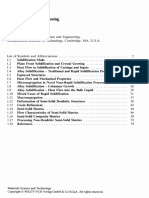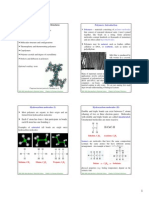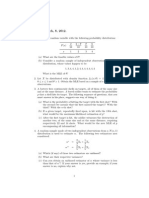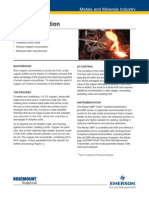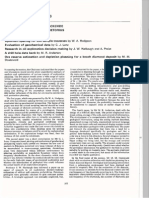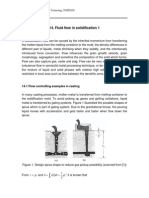Solidification Processing: Lecture 10: Thermodynamics 3
Uploaded by
Anonymous T02GVGzBSolidification Processing: Lecture 10: Thermodynamics 3
Uploaded by
Anonymous T02GVGzBSolidification Processing
Lecture 10: Thermodynamics 3
Thermodynamic driving force
Solidification
Thermodynamic driving force
S S S
TS H G =
L L L
TS H G =
S T H
S S T H H
G G G
L S L S
L S
A A =
=
= A
) ( ) (
Thermodynamic driving force
When T is not far away from T
m
m
H H A = A
m
S S A = A
m m m
T H S / A = A
m
m
T
T H
G
A A
= A
When T is far away from T
m
|
.
|
\
|
A A +
A A
= A
T
T
T T C
T
T H
G
m
p
m
m
ln
Effect of pressure on solidification
More general free energy
TS PV U F + =
When pressure changes
T S P V F
L L L
A A = A
T S P V F
S S S
A A = A
Effect of pressure on solidification
At new melting point
S L
G G A = A
( ) ( ) T S S P V V
L S L S
A = A
m
m
m
H
V T
S
V
P
T
A
A
=
A
A
=
A
A
Effect of pressure on solidification
Antimony, Bismuth Most metals
~0.01 K/atm.
Bubble burst
High pressure ->grain refine
Effect of pressure on solidification
Effect of curvature on solidification
Pressure difference
ko o 2
1 1
2 1
=
|
|
.
|
\
|
+ =
r r
P P
L S
Sphere k=1
Cylinder k=1/2
Effect of curvature on solidification
T S P V F
L L L L
A A = A
T S P V F
S S S S
A A = A
T S V T S
S S L
A = A ko 2
k
ko ko
d
H
V T
S
V
T
m
S m S
=
A
=
A
= A
2 2
Capillary length
SL4
T T
m
Magnetic contribution to thermodynamics
Fe, Ni, Co and their alloys
Curie temperature = The temperature
above which a ferromagnetic material
loses its permanent magnetism
Neel temperature = The temperature at
which an antiferromagnetic material
becomes paramagnetic
Magnetic contribution to entropy
( ) t h B RT H
mag
) 1 ln(
0
+ =
Magnetic contribution to enthalpy
Magnetic contribution to Cp
Magnetic contribution to Gibbs energy
Heat capacity of Co and Ni
About the thermodynamics
To predict if the reaction happens
To estimate new processing method
You might also like
- Feynman Lectures Simplified 1B: Harmonic Oscillators, & ThermodynamicsFrom EverandFeynman Lectures Simplified 1B: Harmonic Oscillators, & ThermodynamicsNo ratings yet
- Chapter Outline: Failure Fracture: How Do Materials Break?No ratings yetChapter Outline: Failure Fracture: How Do Materials Break?9 pages
- Manufacturing Processes (ME361) Lecture 25 and 27No ratings yetManufacturing Processes (ME361) Lecture 25 and 2740 pages
- Manufacturing Processes (ME 361) - Lecture 8: Instructor: Shantanu BhattacharyaNo ratings yetManufacturing Processes (ME 361) - Lecture 8: Instructor: Shantanu Bhattacharya13 pages
- Fundamentals of Solidification (16 Pages)No ratings yetFundamentals of Solidification (16 Pages)16 pages
- WINSEM2023-24 BMEE302L TH VL2023240504568 2024-01-23 Reference-Material-INo ratings yetWINSEM2023-24 BMEE302L TH VL2023240504568 2024-01-23 Reference-Material-I12 pages
- Metals Have A Sharp Freezing Point While Alloys Freeze Over A Range of TemperatureNo ratings yetMetals Have A Sharp Freezing Point While Alloys Freeze Over A Range of Temperature6 pages
- 09 IPE 2101 LFW 9 Fundamentals of Metal CastingNo ratings yet09 IPE 2101 LFW 9 Fundamentals of Metal Casting25 pages
- Cap 4. Termodinamica Fuera Del EquilibrioNo ratings yetCap 4. Termodinamica Fuera Del Equilibrio34 pages
- Rapid Solidification Processing (RSP) - 2022No ratings yetRapid Solidification Processing (RSP) - 202223 pages
- Manufacturing Engineering and TechnologyNo ratings yetManufacturing Engineering and Technology4 pages
- Metallic Materials Topic 2. Solidification of MetalsNo ratings yetMetallic Materials Topic 2. Solidification of Metals41 pages
- CH 6-Cooling and Solidification of Casting100% (1)CH 6-Cooling and Solidification of Casting33 pages
- 2a Sim Am-Amis-fame Elaboration 1 Solidif Antoni 2023-24No ratings yet2a Sim Am-Amis-fame Elaboration 1 Solidif Antoni 2023-2442 pages
- Chapter 4-I-III- Imperfections in SolidsNo ratings yetChapter 4-I-III- Imperfections in Solids70 pages
- Solidification, Phase Diagrams and Phase TransformationNo ratings yetSolidification, Phase Diagrams and Phase Transformation35 pages
- Pressure, Heat and Temperature - Physics for Kids - 5th Grade | Children's Physics BooksFrom EverandPressure, Heat and Temperature - Physics for Kids - 5th Grade | Children's Physics BooksNo ratings yet
- Burdukova Et Al. 2006. Effect of CMC and PH On The Rheology of Suspensions of Isotropic and Anisotropic MineralsNo ratings yetBurdukova Et Al. 2006. Effect of CMC and PH On The Rheology of Suspensions of Isotropic and Anisotropic Minerals15 pages
- Copper Flotation: Metals and Minerals IndustryNo ratings yetCopper Flotation: Metals and Minerals Industry2 pages
- Exploration Analysis: Evaluation of Geochemical Data C. JNo ratings yetExploration Analysis: Evaluation of Geochemical Data C. J2 pages
- Kinetics of Solidification 3: 13.1 Solid-Liquid Interface StructureNo ratings yetKinetics of Solidification 3: 13.1 Solid-Liquid Interface Structure7 pages
- Heat Transfer: Graduate Institute of Ferrous Technology, POSTECH Rongshan Qin (R. S. Qin)No ratings yetHeat Transfer: Graduate Institute of Ferrous Technology, POSTECH Rongshan Qin (R. S. Qin)8 pages
- Case Study: Flow Models: 16.1 Lattice-Gas Automata ModelNo ratings yetCase Study: Flow Models: 16.1 Lattice-Gas Automata Model9 pages
- Phase Field Models: Graduate Institute of Ferrous Technology, POSTECH Rongshan Qin (R. S. Qin)No ratings yetPhase Field Models: Graduate Institute of Ferrous Technology, POSTECH Rongshan Qin (R. S. Qin)10 pages
- Feynman Lectures Simplified 1B: Harmonic Oscillators, & ThermodynamicsFrom EverandFeynman Lectures Simplified 1B: Harmonic Oscillators, & Thermodynamics
- Chapter Outline: Failure Fracture: How Do Materials Break?Chapter Outline: Failure Fracture: How Do Materials Break?
- Manufacturing Processes (ME 361) - Lecture 8: Instructor: Shantanu BhattacharyaManufacturing Processes (ME 361) - Lecture 8: Instructor: Shantanu Bhattacharya
- WINSEM2023-24 BMEE302L TH VL2023240504568 2024-01-23 Reference-Material-IWINSEM2023-24 BMEE302L TH VL2023240504568 2024-01-23 Reference-Material-I
- Metals Have A Sharp Freezing Point While Alloys Freeze Over A Range of TemperatureMetals Have A Sharp Freezing Point While Alloys Freeze Over A Range of Temperature
- Metallic Materials Topic 2. Solidification of MetalsMetallic Materials Topic 2. Solidification of Metals
- 2a Sim Am-Amis-fame Elaboration 1 Solidif Antoni 2023-242a Sim Am-Amis-fame Elaboration 1 Solidif Antoni 2023-24
- Solidification, Phase Diagrams and Phase TransformationSolidification, Phase Diagrams and Phase Transformation
- Pressure, Heat and Temperature - Physics for Kids - 5th Grade | Children's Physics BooksFrom EverandPressure, Heat and Temperature - Physics for Kids - 5th Grade | Children's Physics Books
- Burdukova Et Al. 2006. Effect of CMC and PH On The Rheology of Suspensions of Isotropic and Anisotropic MineralsBurdukova Et Al. 2006. Effect of CMC and PH On The Rheology of Suspensions of Isotropic and Anisotropic Minerals
- Exploration Analysis: Evaluation of Geochemical Data C. JExploration Analysis: Evaluation of Geochemical Data C. J
- Kinetics of Solidification 3: 13.1 Solid-Liquid Interface StructureKinetics of Solidification 3: 13.1 Solid-Liquid Interface Structure
- Heat Transfer: Graduate Institute of Ferrous Technology, POSTECH Rongshan Qin (R. S. Qin)Heat Transfer: Graduate Institute of Ferrous Technology, POSTECH Rongshan Qin (R. S. Qin)
- Case Study: Flow Models: 16.1 Lattice-Gas Automata ModelCase Study: Flow Models: 16.1 Lattice-Gas Automata Model
- Phase Field Models: Graduate Institute of Ferrous Technology, POSTECH Rongshan Qin (R. S. Qin)Phase Field Models: Graduate Institute of Ferrous Technology, POSTECH Rongshan Qin (R. S. Qin)





















